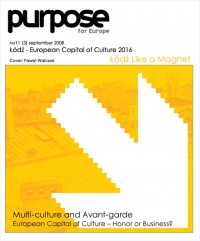
Analysis
European Capital of Culture - honor or business?
In ancient times there was the capital of Egypt, the dominance of Athens and the great importance of Rome. Later towns ceased to exert so much influence, and cultural centers became more dispersed. For hundreds of years European culture was developing in monasteries and estate manors. Only late Middle Ages saw the revival of cities.
During the Renaissance European culture was pushed forward by Italian towns. Artists from Florence introduced some new ideas in the 15th century. It was at the end of that century when the Papal court in Rome had built its power and, after Sacco di Roma, gave the top priority to Venice. In early baroque Rome regained its significance, becoming an important and influential European cultural center until the end of the 18th century. The city evolved into a favorite destination for artists who wanted to study, analyze ancient cultures, and make an artistic career. Other European cities with royal courts, however, were also becoming more and more important – Paris, Vienna, Berlin, and London. It was quite obvious that the development of culture was largely dependent upon economic and political power. Paris was successful in establishing its cultural position, so was Madrid at first (it became less important later). London, a capital slightly remote from the rest of Europe, was strong but exerted little influence on the others.
The second half of the 18th century saw a totally new period in the development of western culture and civilization – because of USA and its rapid growth. It took the Americans 100 more years to build its political and economic power. They were completely influenced by the Europeans in regard to art and culture. At that time Paris was seen as the unquestionable capital of culture. It dominated everything and set new trends in arts, painting in particular. The most important exhibitions and first avant-garde movements would take place in Paris. Even though other centers were more and more influential in regard to their cultural identity, every artist who wanted to have a real career had to go to Paris. This town became a mecca for painters. For example a group of Polish art students went to Paris in the 1920s so as to finish their education.
Europe lost the position of a global cultural leader after World War II. New York matured into a place setting new trends. Not only did American artists not have to come to Europe any more to become famous, but also they had a lot of influence over what was going on in the world of art. Obviously the process was related to American power in economy and politics. The world is multipolar these days – The United States is still a very strong country, the EU wanting to keep pace with it; Russia does not seem to be willing to give up its imperial ambitions; and we have new Asian economic giants such as China and India, not to mention Japan and South Korea. Culture is undergoing the process of decentralization – New York is no longer seen as the only trend setter, other places have a cultural say too. For example Polish pavilions in Saragossa EXPO and Architecture Biennale in Venice were extremely successful.
Europeans realize that culture is turning into a very good export product that can be successfully advertised and which allows for true integration. It was in 1985 that upon the initiative of Melina Mercouri, the Greek minister of culture, the European Council put forward the idea of European Cities of Culture. Athens was the first one. In 1985 this city, supported by European funds, was able to execute cultural projects and rebuild the image of Greek culture. Since then many other European cities have been able to follow a similar pattern. The initiative was renamed in 1999 into the European Capital of Culture, and since 2005 there have been new procedures related to awarding the title. Every year two EU states are selected to carry out competitions selecting the final winner from among numerous candidatures. In 2016 the ECC title will be held by cities from Spain and Poland. The competitions have already begun. In our country there are 7 aspiring cities – Gdañsk, Lublin, £ód¼, Poznañ, Szczecin, Toruñ and Warsaw.
Let us hope that our towns will not use their candidatures only for propaganda purposes. It is crucially important to activate cultural circles and reevaluate the understanding of culture in today’s world. We must understand that cultural institutions are not huge devourers of tax payers’ money, but rather centers generating some positive energies we all need. There will be no losers in the ECC competition and paying too much attention to the title itself does not pay off.

illustration: Tomasz Kaczkowski
Check the archive

nr 48 August 2008
theme of the issue:
Łódź -European Capital of Culture 2016
< spis treści
Article
From the Editors
Interview
Let's talk about Łódź - Artur Zaguła
Presentation
ŁÓDŹ -European Capital of Culture, best candidate
Analysis
European Capital of Culture - honor or business? - Artur Zaguła
Career in culture
Multicultural and avant-garde - Maja Ruszkowska-Mazerant
Culture Industries
Łódź industry - Maciej Mazerant
Workshop
Step by step - Anna Jankowska
Young culture
Magnetic Force - Maja Ruszkowska-Mazerant
On the margin
The Honorary Cimmitte - Łódź City Hall





